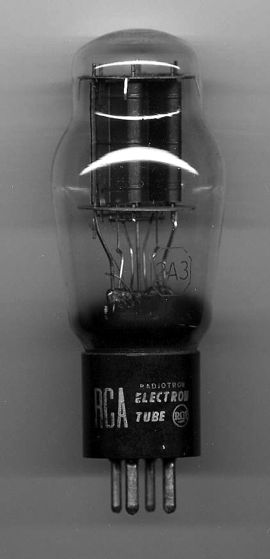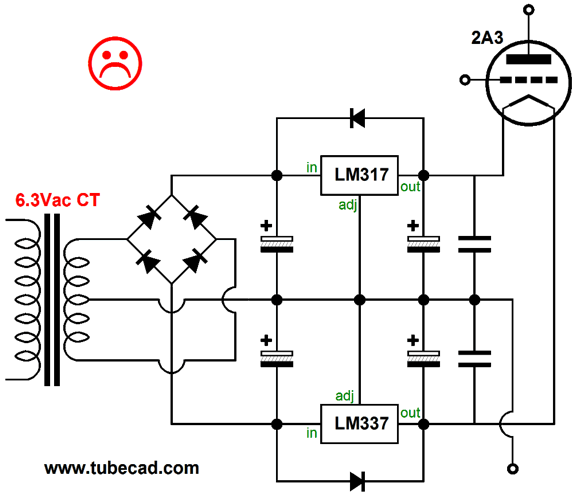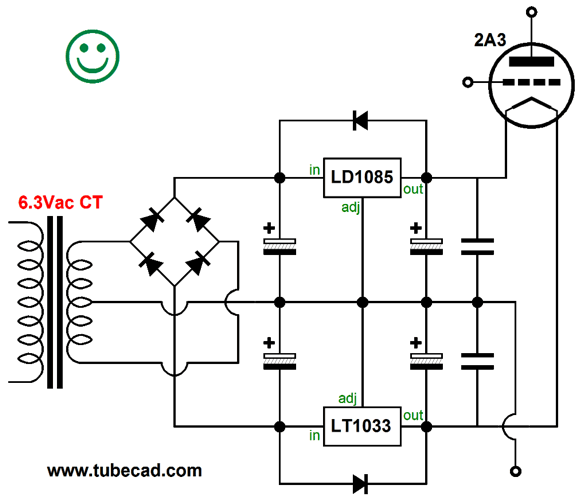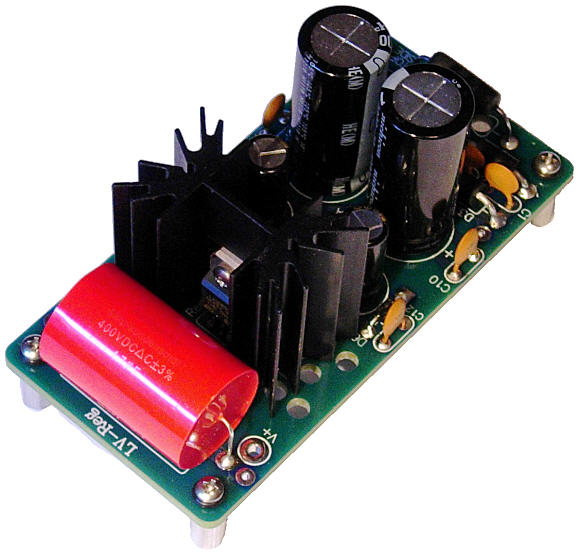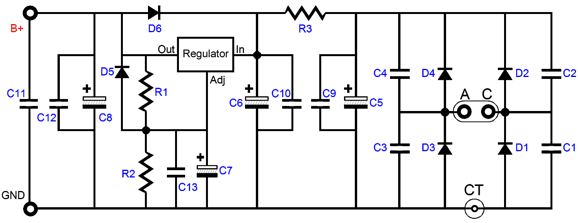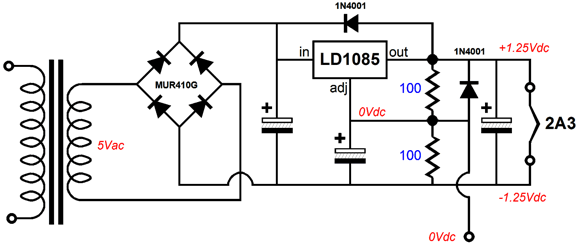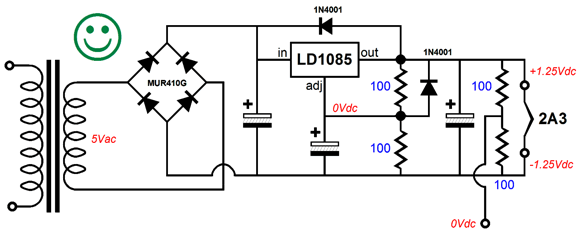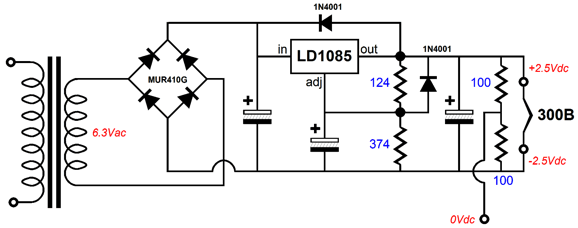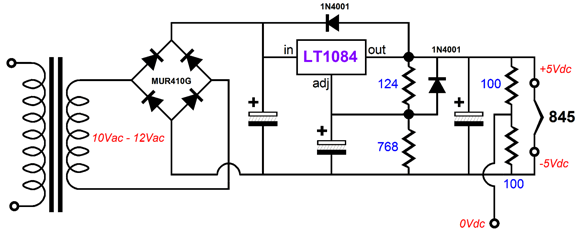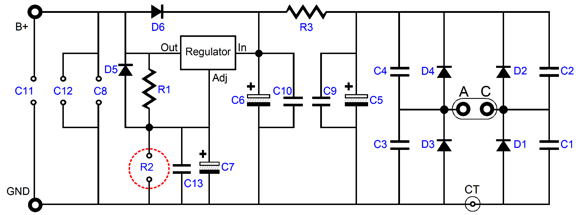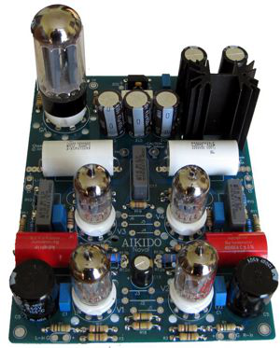| John Broskie's Guide to Tube Circuit Analysis & Design |
20 February 2017 Post Number 372-B This is not a real post; instead it is quick amendment to post 372. What happened was that two readers wrote asking about DC voltage regulators for directly-heated triodes (DHT) and whether the bi-polar regulator was an important improvement over a single polarity regulator. And one reader asked if a 5V version could be made for 300B tubes. Thus, working the assumption that for every reader who bothers to write in a question there are 100 who also desire the answer, but could not bring themselves to the task, I decided that I had to make this upade post. (I know several guys whose insanely short e-mails seemingly reveal a writing reluctance that borders on psychopathy. It is almost as if they believed that each letter they type will subtract one day from their life span.) No one, however, wrote to point out that the 2A3 filament draws 2.5A, which precludes using the devices I specified. So, I must conclude that fewer than 100 readers spotted that problem.
DC Voltage Regulators for DHT Filaments
This was not its first appearance here, as I showed this topology back in July 2000. (Please forgive the low-res GIF image.)
The above regulated power supply for the 2A3 used an LM150 and LM333, which are now too-long-in-the-tooth or no longer made. The modern regulators are the LD1085 (or LT1085) and the LT1033.
Okay, now the answer to the question: Is this bipolar regulator an important improvement over the single polarity regulator? No, not really. In fact, I would only use when I only had a 6.3Vac center-tapped heater available to me and I wanted to heat a 2A3. The problem with the 6.3Vac winding is that rectifies up to too much DC voltage, so a single regulator, such as the LD1085 would get twice as hot as the 2A3 filament. With the positive and negative regulators, each would only get as hot as the 2A3 filament. Indeed, my actual first choice would be one of my LV-Regulator, which I specifically designed for audio use.
This little regulator always brings a smile to my audiophile buddies when I replace their existing DAC's wallwart power supply with an LV-Regulator. (In fact, twice I was not allowed to take my LV-Regulator home with me, after letting a friend hear the difference it made to their Squeezebox, as my friends couldn't bear to return to their switching wallwart.)
The LV-Regulator's output voltage is adjustable from 2.5V to 24V. The LV-Regulator uses a simple RC filter (1 ohm & 10kµF) as a pre-filter before the LDO regulator and holds bypass capacitors for all the electrolytic capacitors and a 4.7µF/400V polypropylene shunting capacitor at the output. It uses a 3A low-dropout regulator (LD1085) and two resistors set the output voltage value. One problem, however, is that he 1-ohm resistor that comes with the kit is a 4W device, so the maximum current output is 2A. The 2A3's filament draws 2.5A, which would result in 6.25W of heat from the 1-ohm resistor. I will now offer a 2A3-arrangement for the LV-Regulator that will use a 0.33-ohm RC resistor instead of the 1-ohm/4W resistor.
In fact, I am putting the LV-Regulator (and the Janus Regulator) on sale right now. (I bought too many 5Y3 rectifiers and this will thin down my stock of them.) Returning to the issue of heating a DHT filament, here is one possible setup.
Since the two 100-ohm resistors see the same voltage drop, the nexus between the two seems a good place to attach either the ground connection or a cathode-bias resistor. I am sure that this would work just fine, but I would prefer to use the following variation instead.
Two additional 100-ohm resistors are needed. These added resistor will present the same impedance to either ground or the cathode resistor, which the previous arrangement is less likely to do the same, as one resistor is bypassed by a large-valued capacitor, while the other isn't. That's great, John, but I only run 300B output tubes and their filament draws 1.2A at 5V. No problem. We use a slightly higher heater winding voltage (6.3Vac) and different resistor values to set the output voltage.
That's great, John, but I only run 845 output tubes and their filament draws 3.5A at 10V. Once again, no problem. We use an even higher heater winding voltage (10Vac to 12Vac) and different resistor values to set the output voltage.
Note the LT1084, which is a 5A positive adjustable regulator. That's great, John, but everyone knows that filaments work best with constant-current source power supplies. Really, I didn't know that quid facti, only quid juris. Well, here is how an LV-Regulator can be set up with constant-current output.
Resistor R1 set the current flow. The formula is easy enough: R1 = 1.25V/Iout For example, for 1.2A current flow, use either a 1.03- or 1.05-ohm resistor value; for 2.5A out, a 0.5-ohm resistor (two 1-ohm resistors in parallel). The output is taken at resistor R2's solder pads.
Next Time
//JRB
If you have been reading my posts, you know that my lifetime goal is reaching post number one thousand. I have 628 more to go. My second goal is to gather 1,000 patrons. I have 969 patrons to go. If you enjoyed reading this post from me, then you might consider becoming one of my patrons at Patreon.com.
User Guides for GlassWare Software
For those of you who still have old computers running Windows XP (32-bit) or any other Windows 32-bit OS, I have setup the download availability of my old old standards: Tube CAD, SE Amp CAD, and Audio Gadgets. The downloads are at the GlassWare-Yahoo store and the price is only $9.95 for each program. http://glass-ware.stores.yahoo.net/adsoffromgla.html So many have asked that I had to do it. WARNING: THESE THREE PROGRAMS WILL NOT RUN UNDER VISTA 64-Bit or WINDOWS 7 & 8 or any other 64-bit OS. I do plan on remaking all of these programs into 64-bit versions, but it will be a huge ordeal, as programming requires vast chunks of noise-free time, something very rare with children running about. Ideally, I would love to come out with versions that run on iPads and Android-OS tablets. //JRB |
E-mail from GlassWare Customers
High-quality, double-sided, extra thick, 2-oz traces, plated-through holes, dual sets of resistor pads and pads for two coupling capacitors. Stereo and mono, octal and 9-pin printed circuit boards available. http://glass-ware.stores.yahoo.net/ Support the Tube CAD Journal & get an extremely powerful push-pull tube-amplifier simulator for TCJ Push-Pull Calculator
TCJ PPC Version 2 Improvements Rebuilt simulation engine *User definable
Download or CD ROM For more information, please visit our Web site : To purchase, please visit our Yahoo Store: |
|||
| www.tubecad.com Copyright © 1999-2017 GlassWare All Rights Reserved |
